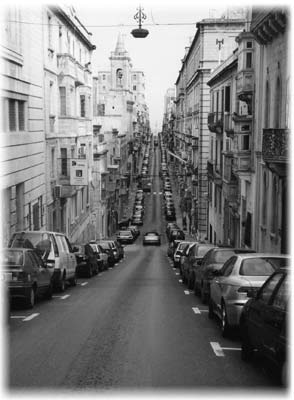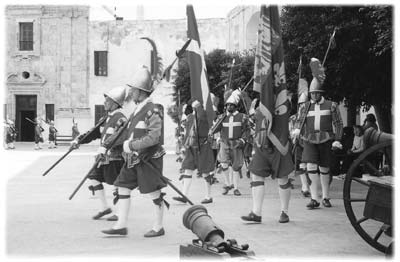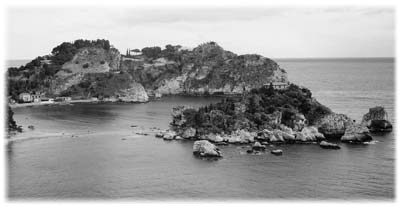Historical Malta
—by Vernon Hoium, Minneapolis, MN
When the temperature in Minneapolis reached 14 degrees below zero, it was time to think of visiting a warmer climate. In January ’05, my wife and I flew from Minneapolis to Malta via London. We purchased two separate tickets for the trip, traveling to London on Northwest Airlines and from London to Malta with British Airways, allowing us to have a 3-day stopover in London on our return trip. (The airfare from London to Malta was only $200 for the 3-hour-and-20-minute trip.)
Getting settled
Upon arrival in Malta we were met by a representative of Sundreams Travel (phone 356 21 380133 or visit www.sundreamstravel.com), who made the basic arrangements for this trip. Their representative drove us to our hotel, the Sand Peebles, located on the waterfront in Sliema, one of Malta’s largest cities. This was a very good location from which to enjoy the local shops and cafés, and it provided easy access by bus to the capital city of Valletta.
The Peebles apartment hotel (89, The Strand) is a 2-star accommodation which could sleep up to four and had kitchen facilities for limited cooking. The only drawback was that it did not have central heating, only a portable electric heater. For the summer, it had a through-the-wall air-conditioner that provided five hours of cooling for one lira (about $3).
I would recommend this apartment hotel for someone who desires kitchen facilities, but next time I would choose different accommodations. The off-season cost for the Peebles was only $60 per night, but for the same sum you could get a bed and breakfast at The Sliema Hotel (59, The Strand; phone 356 21 324886 or visit www. sliemahotel.com), a 3-star hotel about a block away. The Waterfront Hotel (The Strand; phone 356 21 333434), a 4-star, cost about $100 per night, including breakfast. Both of these facilities had central heating and air-conditioning.
A bit of history
Malta is located just a short distance southeast of the tip of Sicily. Consisting of five islands, only two of which have a sizable population, Malta measures 122 square miles — smaller than the city of Philadelphia.
From our base in Sliema, it was very easy to go to the city of Valletta by bus, which took only about 15 minutes. In the summer, there is also a ferry across the bay to Valletta. Staying in Sliema is more attractive because there are many more hotels to choose from than there are in Valletta.
Sundreams Travel arranged a full day of sightseeing on the island of Malta for us plus a second day on the island of Gozo. We also took a 30-minute flight to Catania, Sicily, and spent a day sampling a little of that island.
One of the first things that a visitor to Malta should do is attend the audiovisual spectacular “The Malta Experience.” This movie traces the history of, and gives the visitor an orientation to, the island. From October to June it is shown hourly from 11 a.m. to 4 p.m. (or 11-2 Saturday and Sunday) at Fort St. Elmo in Valletta.
Anyone interested in the history of Malta during World War II might want to attend another movie, “Malta At War,” which is shown hourly from 10 a.m. to 1 p.m. This movie traces the events of WWII in relation to Malta.
It is reported that during the war, more bombs were dropped on Malta than any other location. First the Italians bombed, then later the Germans.
Malta is one of the best natural harbors in the Mediterranean, and therefore both sides wanted it badly. The Germans wanted Malta as a jumping-off base for strikes on North Africa, and the Allies wanted it as a base for their invasion of Sicily. Fortunately, the Allies maintained control of Malta throughout the War.
Island sights
After seeing the two movies in Valletta, we visited St. John’s Co-Cathedral. Malta’s greatest treasure, it included the famous 17th-century “Beheading of St. John the Baptist,” a painting by Caravaggio.
The main street of Valletta is called a “public street,” and you can walk from the city gate at one end all the way to St. Elmo Fort at the other. A distance of about 15 short blocks, it is lined with shops and things to see on both sides. There is also a number of governmental buildings here that are interesting to visit.
After spending the first day on a walking tour around Valletta, on the second day we hired a car, driver and guide ($200) to show us the island of Malta.
We left Sliema and proceeded to the fishing village of Marsaxlokk on the south coast. The harbor here was filled with very colorful fishing boats that reminded me of a bygone era. There is also a bazaar in the village where the locals sell various Maltese handicrafts.
We proceeded on to the city of Mdina, which from a distance looked like a fort or a walled city. We visited St. Paul’s Cathedral in the city and had a panoramic view of the island, then continued on to the village of Rabat to visit St. Paul’s Grotto and take a walking tour of the village.
We returned to Mdina for our last day in Malta and visited the Bacchus Restaurant (Inguanez St.; phone 356 21 454981), one of the most famous restaurants in Malta. Dinner for two, including a bottle of local wine, entrée and coffee, cost about $75.
Our next stop, the village of Mosta, was located in the center of the island. This village is best known for the Mosta Dome, a church that was completed in 1860. The church’s dome has an interior diameter of 39.6 meters (about 130 feet) and is reputed to be the third largest in the world after St. Peter’s in Rome and Hagia Sophia in Istanbul. At Mosta you can enjoy pleasant views of the Burmarrad Plains, and in the distance you can see St. Paul’s Bay.
Sicily
The following morning, we took a 30-minute flight from Malta to Catania, Sicily, and hired another private car and driver ($300) to take us around Catania and Taormina for the day.
After a walking tour through the center of Catania, we spent some time visiting an open market where they were selling produce, meat, fish and other staples. It was amazing how large the market was and how many shoppers there were in the early morning.
Most of Catania’s majestic palaces were built during the 18th century. Our city tour included the Roman Anfiteatro, the Greek Theatre, the cathedral, the Theatre Maximum Bellini and the Etnea streets, with examples of Sicilian Baroque architecture. Also included in the tour was the ancient university and the monastery of the Benedictines.
From the city of Catania we drove toward Taormina, passing along the Cyclops Riviera. Taormina is located on a plateau below Mt. Tauro, for which it is named. The city has winding medieval streets and tiny passages that only permit walking. It also has many restaurants and cafés.
One of the most famous attractions is the view overlooking the Greco-Roman Amphitheater, one of Sicily’s largest, with Mt. Etna and the sea visible in the background. From Taormina we drove back to Catania and caught a late-afternoon flight back to Malta.
The island of Gozo
Our third and final excursion was to the smaller island of Gozo. Again we hired a car, driver and guide for about $200 and spent the day on the island.
We left Sliema and drove along the north coast of Malta Island, enjoying some very picturesque views of the sea, and boarded a car-and-passenger ferry for a half-hour cruise to Gozo.
On Gozo we visited Victoria, the capital of the island, and went up to the citadel to walk through the ancient ruins. The houses in this area are medieval and are unique on the Maltese Islands.
There is a magnificent cathedral and also St. George’s Basilica, which dominates the square in Victoria. Finally, we admired the beautiful panorama of the island from Victoria’s Bastion.
We also visited Lunzjata Valley, one of the greenest places found here all year ’round.
Comino, the third island in the chain, is not open for sightseeing.
On our final day in Malta, a Sunday, we again visited Fort St. Elmo and saw the changing of the guard ceremony in the tradition of the Knights of Malta. This ceremony is performed two or three times a month throughout the year, with approximately 80 participants dressed in period costumes that date back to 1565. It is quite an impressive show, and I would recommend a visit if you are there on a Sunday when it is performed.
Recommendations
All in all, Malta offered a very interesting experience. During our January visit, the temperature was between 45° and 60°F. During midsummer, temperatures get up into the high 90s, so going off-season ensures much smaller crowds and more agreeable temperatures.
While we were in Malta, we visited several restaurants that I would recommend. One of our favorites in Sliema was a German restaurant called Trees (286 Manuel Dimech St.; phone 356 2133 3966). We had a half liter of local wine, Wiener schnitzel and coffee for a total of $27 for two. Another restaurant, Il’Galeon (Tigne Seafront; phone 356 316420), specializes in seafood. Here, our meal with wine, entrée and coffee ran around $39 for two.
In Valletta I would recommend Café LaVeneziana (29/30 Melita St.; phone 356 222513), where we had coffee and pastries.
We enjoyed Malta and would recommend it to anyone who enjoys visiting a place off the beaten path.





